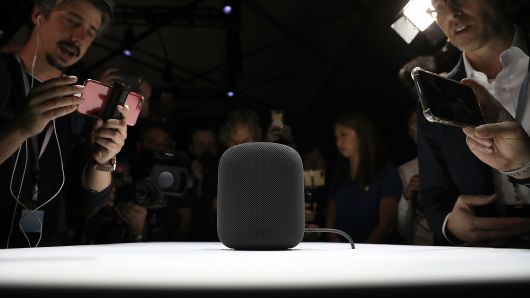
Getty Images
A prototype of Apple’s new HomePod is displayed during the 2017 Apple Worldwide Developer Conference (WWDC) at the San Jose Convention Center on June 5, 2017 in San Jose, California.
Apple’s smart speaker is struggling to grab market share from the Amazon Echo and Google Home. A new analysis by Consumer Intelligence Research Partners (CIRP) found Apple’s HomePod makes up only 6 percent of the 66 million units that make up the U.S. installed base of smart speaker devices.
As the number of active smart speaker devices continues to grow, Apple’s has failed to keep up with the rest of the market. The Google Home makes up 24 percent of the U.S. installed base and Amazon’s Alexa-enabled Echo accounts for 70 percent, according to the report.
Apple’s HomePod, at $349, is more expensive and more limited than other smart speaker devices. By comparison, Google offers smart speakers starting at $29.99 and Amazon offers them starting at $19.99. While the HomePod prides itself on high-quality audio and the fact that it does not store conversations in the cloud as other devices do, the number of services it supports is narrower compared to its competitors. Siri will only listen to commands to play music from Apple’s own streaming service, and playing from other services, like Spotify, require a more complicated set-up.
Apple has shifted its strategy around Apple Music, beginning to offer the service on smart speakers that hold more market share. In November, Amazon said Apple Music would be available on the Echo, marking a rare collaboration between the two companies. The move comes as Apple looks outside its own closed-off ecosystem to drive more subscribers for its services.
CIRP Co-Founder and Partner Mike Levin said Amazon and Google’s strategies of offering lower priced devices so people can own more than one in their home seems to be working. The report said 35 percent of smart speaker owners have more than one device as of the December 2018 quarter, compared to 18 percent the year before.
“Their strategies appear to include persuading owners to use smart speakers in multiple rooms, which helps create more active usage of the voice platform,” Levin said of Amazon and Google. “And, Google has mostly caught up to Amazon in this strategy. A year ago, almost twice the percentage of Amazon Echo users had multiple units as Google Home users. Now, about one-third of both Amazon Echo and Google Home users have multiple units.”
Subscribe to CNBC on YouTube.
Watch: Apple’s HomePod sounds great but you should probably just buy a Sonos
 EU News Digest Latest News & Updates
EU News Digest Latest News & Updates



